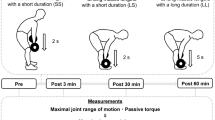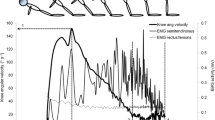Abstract
Aim of this study was to evaluate shift of optimum angle in hamstrings and quadriceps after single resistance exercise session performed at different muscle lengths. Thirteen healthy sport students volunteered for this study. The intervention consisted of ten sets × ten maximal concentric-only knee flexions or extensions exercised at long muscle length in hamstrings and short muscle length in quadriceps. Total work for each set was recorded and analyzed. Before and immediately after the exercise session isometric maximal voluntary contraction (MVC) was recorded both for hamstrings and quadriceps at 20°, 30°, 40°, 50°, 60°, 70° and 80° of knee extension. Compared to the first set, total work significantly decreased starting from the second set in hamstrings and from the fourth set in quadriceps. Immediately after exercise, MVC was significantly (p < 0.05) lower than baseline in all conditions. The optimum angle shifted towards longer muscle in hamstrings (from 50° to 20°) but not in quadriceps (pre and post = 70°). Our outcomes showed that concentric-only resistance exercise performed at long (hamstrings) but not at short (quadriceps) muscle length induced shift of peak joint torque angle towards longer muscle. However, different rate of fatigability between hamstrings and quadriceps could have influenced such shift.


Similar content being viewed by others
References
Chen TC, Nosaka K, Sacco P (2007) Intensity of eccentric exercise, shift of optimum angle, and the magnitude of repeated-bout effect. J Appl Physiol 102:992–999. doi:10.1152/japplphysiol.00425.2006
Philippou A, Bogdanis GC, Nevill AM, Maridaki M (2004) Changes in the angle-force curve of human elbow flexors following eccentric and isometric exercise. Eur J Appl Physiol 93:237–244. doi:10.1007/s00421-004-1209-z
Coratella G, Bertinato L (2015) Isoload vs isokinetic eccentric exercise: a direct comparison of exercise-induced muscle damage and repeated bout effect. Sport Sci Health 11:87–96. doi:10.1007/s11332-014-0213-x
Morgan DL, Proske U (2004) Popping sarcomere hypothesis explains stretch-induced muscle damage. Clin Exp Pharmacol Physiol 31:541–545. doi:10.1111/j.1440-1681.2004.04029.x
Morgan DL (1990) New insights into the behavior of muscle during active lengthening. Biophys J 57:209–221. doi:10.1016/S0006-3495(90)82524-8
Whitehead NP, Morgan DL, Gregory JE, Proske U (2003) Rises in whole muscle passive tension of mammalian muscle after eccentric contractions at different lengths. J Appl Physiol 95:1224–1234. doi:10.1152/japplphysiol.00163.2003
Child RB, Saxton JM, Donnelly AE (1998) Comparison of eccentric knee extensor muscle actions at two muscle lengths on indices of damage and angle-specific force production in humans. J Sports Sci 16:301–308. doi:10.1080/02640419808559358
Newham DJ, McPhail G, Mills KR, Edwards RH (1983) Ultrastructural changes after concentric and eccentric contractions of human muscle. J Neurol Sci 61:109–122
Yeung SS, Yeung EW (2008) Shift of peak torque angle after eccentric exercise. Int J Sports Med 29:251–256. doi:10.1055/s-2007-965337
Guex K, Degache F, Gremion G, Millet GP (2013) Effect of hip flexion angle on hamstring optimum length after a single set of concentric contractions. J Sports Sci 31:1545–1552. doi:10.1080/02640414.2013.786186
Morgan DL, Gregory JE, Proske U (2004) The influence of fatigue on damage from eccentric contractions in the gastrocnemius muscle of the cat. J Physiol 561:841–850. doi:10.1113/jphysiol.2004.069948
Balle SS, Magnusson SP, McHugh MP (2015) Effects of contract-relax vs static stretching on stretch-induced strength loss and length–tension relationship. Scand J Med Sci Sports. doi:10.1111/sms.12399
Katz B (1939) The relation between force and speed in muscular contraction. J Physiol 96:45–64
Brockett CL, Morgan DL, Proske U (2001) Human hamstring muscles adapt to eccentric exercise by changing optimum length. Med Sci Sports Exerc 33:783–790
Brughelli M, Cronin J (2007) Altering the length–tension relationship with eccentric exercise: implications for performance and injury. Sports Med 37:807–826
Garrett WE, Califf JC, Bassett FH (1984) Histochemical correlates of hamstring injuries. Am J Sports Med 12:98–103
Coratella G, Bellin G, Beato M, Schena F (2015) Fatigue affects peak joint torque angle in hamstrings but not in quadriceps. J Sports Sci 33:1276–1282. doi:10.1080/02640414.2014.986185
Delextrat A, Gregory J, Cohen D (2010) The use of the functional H:Q ratio to assess fatigue in soccer. Int J Sports Med 31:192–197. doi:10.1055/s-0029-1243642
Rahnama N, Reilly T, Lees A, Graham-Smith P (2003) Muscle fatigue induced by exercise simulating the work rate of competitive soccer. J Sports Sci 21:933–942. doi:10.1080/0264041031000140428
Butterfield TA, Herzog W (2005) Is the force–length relationship a useful indicator of contractile element damage following eccentric exercise? J Biomech 38:1932–1937. doi:10.1016/j.jbiomech.2004.08.013
Marion MS, Wexler AS, Hull ML, Binder-Macleod SA (2009) Predicting the effect of muscle length on fatigue during electrical stimulation. Muscle Nerve 40:573–581. doi:10.1002/mus.21459
Blazevich AJ, Gill ND, Zhou S (2006) Intra- and intermuscular variation in human quadriceps femoris architecture assessed in vivo. J Anat 209:289–310. doi:10.1111/j.1469-7580.2006.00619.x
Kellis E, Galanis N, Kapetanos G, Natsis K (2012) Architectural differences between the hamstring muscles. J Electromyogr Kinesiol 22:520–526. doi:10.1016/j.jelekin.2012.03.012
Woittiez RD, Huijing PA, Rozendal RH (1983) Influence of muscle architecture on the length-force diagram of mammalian muscle. Pflugers Arch 399:275–279
Mademli L, Arampatzis A (2005) Behaviour of the human gastrocnemius muscle architecture during submaximal isometric fatigue. Eur J Appl Physiol 94:611–617. doi:10.1007/s00421-005-1366-8
McHugh MP, Pasiakos S (2004) The role of exercising muscle length in the protective adaptation to a single bout of eccentric exercise. Eur J Appl Physiol 93:286–293. doi:10.1007/s00421-004-1196-0
Author information
Authors and Affiliations
Corresponding author
Ethics declarations
Conflict of interest
The authors declare that they have no conflict of interest.
Ethical approval
All procedures were in accordance with the ethical standards of the responsible committee on human experimentations (institutional and national) and with the Helsinki Declaration of 1975, as revised in 2000.
Informed consent
Informed consent was obtained from all patients for being included in the study.
Rights and permissions
About this article
Cite this article
Coratella, G., Bellini, V. & Schena, F. Shift of optimum angle after concentric-only exercise performed at long vs. short muscle length. Sport Sci Health 12, 85–90 (2016). https://doi.org/10.1007/s11332-016-0258-0
Received:
Accepted:
Published:
Issue Date:
DOI: https://doi.org/10.1007/s11332-016-0258-0




